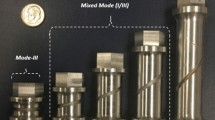Abstract
A simplified method for determining the double-K fracture parameters K Ic ini and K Ic un for three-point bending tests is proposed. Two empirical formulae are used to describe the crack mouth opening displacement CMOD and the stress intensity factor K I c caused by the cohesive force σ(x) on the fictitious crack zone for three-point bending beams. It has been found that the two empirical formulae are accurate for a large practical region of a/D. Experiments carried out by many researchers showed that the new formula of CMOD for three-point bending beams can be directly used to predict the initial crack length for precracked beams, the notch depth and the critical effective crack length, as well as the crack length in the post-critical situation with a satisfactory accuracy. Further verification is demonstrated to determine the double-K parameters K Ic ini and K Ic un. They are very close to those determined by the method proposed in our previous work. Using the simplified procedure, the experiments can be performed even without a closed-loop testing facility and the calculation can be carried out on a pocket calculator.
Similar content being viewed by others
References
Jenq, Y.S. and Shah, S.P. (1985). A fracture toughness criterion for concrete. Engineering Fracture Mechanics 21(5), 1055–1069.
Jenq, Y.S. and Shah, S.P. (1985). Two parameter fracture model for concrete. Journal of Engineering Mechanics, 111(10), 1227–1241.
Nallathamb, P. and Karihaloo, B.L. (1986). Determination of specimen-size independent fracture toughness of plain concrete. Magazine of Concrete Research 38(135), 67–76.
Karihaloo, B.L. and Nallathambi, P. (1989). An improved effective crack model for the determination of fracture toughness of concrete. Cement and Concrete Research, 19, 603–610.
Karihaloo, B.L. and Nallathambi, P. (1990). Effective crack model for the determination of fracture toughness (KsIc) of concrete. Engineering Fracture Mechanics 35(4/5), 637–645.
Swartz, S.E. and Go, C.G. (1984). Validity of compliance calibration to cracked concrete beams in bending. Experimental Mechanics 24, (2), 129–134.
Swartz, S.E. and Refai, T.M.E. (1987). Influence of size on opening mode fracture parameters for precracked concrete beams in bending. Proceedings of SEM-RILEM International Conference on Fracture of Concrete and Rock, (Edited by S.P. Shah and S.E. Swartz), Houston, Texas, 242–254.
Refai, T.M.E. and Swartz, S.E. (1987). Fracture behavior of concrete beams in three-point bending considering the influence of size effects. Report No. 190, Engineering Experiment Station, Kansas State University.
Bazant, Z.P. and Kazemi, M.T. (1990). Determination of fracture energy, process zone length and brittleness number from size effect, with application to rock and concrete. International Journal of Fracture 44, 111–131.
Xu, Shilang and Reinhardt, H.W. (1998). Determination of double-K fracture parameters in standard three-point bending notched beams. Fracture Mechanics of Concrete Structures, Proceedings FRAMCOS-3 (Edited by H. Mihashi and K. Rokugo), Aedificatio Publishers, Freiburg, Germany, Vol. 1, 431–440.
Xu, Shilang and Reinhardt, H.W. (1999). Determination of double-K criterion for crack propagation in quasibrittle materials, part I: experimental investigation of crack propagation. International Journal of Fracture 98(2): 111–149.
Tada, H., Paris, P.C. and Irwin, G.R. (1985). The Stress Analysis of Cracks Handbook. Paris Productions Incorporated, St. Louis, Missouri, USA.
Shah, S.P., Swartz, S.E. and Ouyang, C. (1995). Fracture Mechanics of Concrete, John Wiley & Sons, Inc., New York.
Chen, C., Qigong Cai and Renzhi Wang (1977), Engineering Fracture Mechanics The Press of National Defense Industry, Beijing (in Chinese).
Shah, S.P. (1990). Experimental methods for determining fracture process zone and fracture parameters. Engineering Fracture Mechanics 35(1/2/3), 3–14.
Reinhardt, H.W., Cornelissen, H.A.W. and Hordijk, D.A. (1986). Tensile tests and failure analysis of concrete. Journal of Structural Engineering, 112(11), 2462–2477.
Wolinski, S., Hordijk, D.A., Reinhardt, H.W. and Cornelissen, H.A.W. (1987). Influence of aggregate size on fracture mechanics parameters of concrete. The International Journal of Cement Composites and Lightweight Concrete, 9(2), 95–103.
Karihaloo, B.L. and P. Nallathambi (1991). Notched beam test: mode I fracture toughness. Fracture Mechanics Test Methods for Concrete, Report of RILEM Technical Committee 89-FMT, (Edited by S.P. Shah and A. Carpinteri), Chapman and Hall, London, 1–86.
Xu, Shilang and Reinhardt, H.W. (1999). Determination of double-K criterion for crack propagation in quasibrittle materials, part II: analytical evaluating and practical measuring methods for three-point bending notched beams. International Journal of Fracture 98(2), 151–177.
Xu, Shilang and Reinhardt, H.W. (1999). Determination of double-K criterion for crack propagation in quasibrittle materials, part III: compact tension specimens and wedge splitting specimens. International Journal of Fracture 98(2), 179–193.
Hillerborg, A., Modeer, M. and Petersson, P.E. (1976). Analysis of crack formation and crack growth in concrete by means of fracture mechanics and finite elements. Cement and Concrete Research 6, 773–782.
Bazant, Z.P. and Oh, B.H. (1983). Crack band theory for fracture of concrete. RILEM, Materials and Structures 16(93), 155–177.
Gopalaratnam, V.S. and Shah, S.P. (1985). Softening response of plain concrete in direct tension. ACI Journal, (May-June), 310–323.
Phillips, D.V. and Zhang, B.S. (1983). Direct tension tests on notched and un-notched plain concrete specimens. Magazine of Concrete Research 45(162), 25–35.
Xu, Shilang and Reinhardt, H.W. (1998). Crack extension resistance and fracture properties of quasi-brittle softening materials like concrete based on the complete process of fracture. International Journal of Fracture 92 (1), 71–99. Handbook of the Stress Intensity Factors, Edited by the National Institute of Aviation Research of China, The Science Press, Beijing, 1981.
Elices, M. and Planas, J. (1993). The equivalent elastic crack: 1. Load-Y equivalencies. International Journal of Fracture 61, 159–172.
Author information
Authors and Affiliations
Rights and permissions
About this article
Cite this article
Xu, S., Reinhardt, H.W. A simplified method for determining double-K fracture parameters for three-point bending tests. International Journal of Fracture 104, 181–209 (2000). https://doi.org/10.1023/A:1007676716549
Issue Date:
DOI: https://doi.org/10.1023/A:1007676716549




